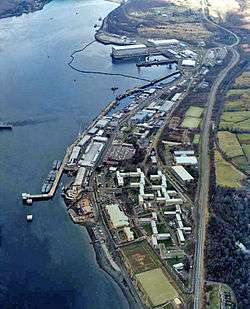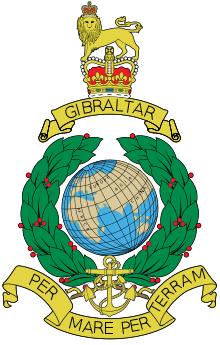43 Commando Fleet Protection Group Royal Marines
| 43 Commando Fleet Protection Group Royal Marines | |
|---|---|
|
Cap Badge of the Royal Marines | |
| Active |
1943–1946 1961–1968 1980 – present |
| Country |
|
| Branch |
|
| Type | Commando |
| Role |
Force protection Maritime Interdiction Operations Nuclear Security |
| Size | 790 personnel |
| Part of | 3 Commando Brigade[1] |
| Base | HMNB Clyde |
| Nickname(s) | FPG |
| Motto(s) | Per Mare Per Terram (By Sea By Land) (Latin) |
| Colours (Lanyard) | Red and Old Gold |
| March |
Quick – A Life on the Ocean Wave Slow – Preobrajensky |
| Anniversaries | Lake Comacchio, 3 April 1945 |
| Website | 43 Commando Fleet Protection Group Royal Marines |
| Commanders | |
| Captain General | HRH The Duke of Edinburgh |
| Commandant General | Major General Robert Magowan CBE |
| Superior Commander | Commander Operations, Fleet Headquarters |
| Current Commander | Colonel Matt Pierson Royal Marines[2] |
| Insignia | |
| Tactical Recognition Flash |
 |

The 43 Commando Fleet Protection Group Royal Marines (43 Cdo FP Gp RM),[3] formerly Comacchio Company Royal Marines (1980–1983), Comacchio Group Royal Marines (1983–2001) and Fleet Protection Group Royal Marines (2001–2012), is a 790-man unit of the Royal Marines responsible for guarding the United Kingdom's Naval nuclear weapons and other security-related duties. It falls under the authority of 3 Commando Brigade.
History
Second World War
Early Commando units were all from the British Army but by February 1942, the Royal Marines were asked to organize Commando units of their own, and 6,000 men volunteered.[4]
43 Commando was formed in July 1943 after the decision was made to convert the battalions of the Royal Marine Division into commando units.[5] The initial intake of personnel was drawn from the 2nd Battalion, Royal Marines,[6] and following commando training at Achnacarry in Scotland, the unit consisted of about 450 men organized into a headquarters, five infantry troops consisting of three officers and 63 other ranks, along with a heavy weapons troop—armed with Vickers machine guns, 3-inch mortars and 6-pounder anti-tank guns—and a signals platoon.[7][8]
Along with No. 2, No. 9 and No. 40 (Royal Marine) Commandos, 43 Commando formed the 2nd Special Service Brigade.[9] Throughout the course of 1943–45, No. 43 (Royal Marine) Commando served in Italy, Yugoslavia and Greece.[10]
Victoria Cross
Corporal Thomas Peck Hunter was posthumously awarded the Victoria Cross for his actions during Operation Roast at Lake Comacchio, Italy during the Second World War. Hunter cleared a farmhouse containing three Spandau machine-guns on his own, firing a Bren Gun from his hip. Hunter then proceeded to draw enemy fire until most of his troop had taken cover.[11] The Commanding Officer, Lt Col Ian Riches RM was also awarded the DSO in this action. He went on to be Commandant General Royal Marines between 1959 and 1962.
Re-forming
43 Commando RM was reformed between 1961–1968 for "as a further contribution to the forces available for seaborne operations".[12]
On 1 May 1980, the Comacchio Company Royal Marines was formed to guard the UK's Naval nuclear weapons and as a Maritime Counter-Terrorism unit for offshore installations, including oil rigs and ships. The Comacchio Company RM initially numbered around 300 personnel.
Taking its name from a Second World War battle honour, the Comacchio Company's purpose was deemed inappropriate for a Commando-level specification. Instead, the Comacchio Company was named after a battle fought in Comacchio, Italy, by Royal Marines in 1945, where Corporal Thomas Peck Hunter of 43 Commando posthumously received the Victoria Cross for his actions. On its formation, Comacchio Company took on the colours and traditions of the-then defunct 43 Commando.
The Comacchio Company RM became Comacchio Group RM in November 1983 to reflect a manpower increase to over 400 Royal Marines. From 1987 onwards, Comacchio Group also ceased performing the Maritime Counter-Terrorism role, after a study transferred the task to the newly formed M-squadron of the Royal Marines Special Boat Service.
The Comacchio Group RM was renamed Fleet Protection Group Royal Marines in March 2001, and was restructured into its current organisation. The Group also moved from RM Condor in Arbroath Angus (where it was co-located with 45 Commando) to HM Naval Base Clyde, which is situated near Helensburgh, Argyll and Bute (both in Scotland).
In 2004, rifle squadron P was renamed S squadron and the Group was further expanded to a complement of 530. In 2012, FPGRM formally adopted the name 43 Commando.[13]
In 2016, it was announced that the whole unit would be using the Colt Canada C8 carbine instead of the standard L85A2.[14]
Commanding Officers
Fleet Protection Group
- 2001–2002 Col M J D Noble
- 2002–2003 Col M W Dunham
- 2003–2005 Col I P Huntley
- 2005–2007 Col P R Denning OBE
- 2007–2009 Col R A W Spencer OBE
- 2009–2011 Col M N Gray MBE
- 2011– Col A Litster OBE[15]
43 Commando Fleet Protection Group Royal Marines
- 2011–2013 Col A Litster OBE [16]
- 2013–2015 Col M F Pierson
- 2015–present Col G W Fraser
Tasks and organisation
As of 2009, the Fleet Protection Group has over 550 personnel and is organised into several sub-units:
- Headquarters Squadron, including Boat Troop
- O Rifle Squadron
- R Rifle Squadron
- S Rifle Squadron
- P Squadron Royal Navy[17] (a sub-unit created in 2010 comprising 145 Royal Navy personnel charged with protecting RFA ships, Mine warfare ships and MOD-owned ferries) P Squadron has disbanded with its role taken over by members of 45 Commando or the Standing Task Commando Regiment.[18]
The Group currently performs several tasks, including:
- Fleet Standby Rifle Troop (FSRT) – The Group provides a number of teams to conduct tasks in support of the Royal Navy worldwide, including counter-terrorist, counter-narcotics and counter-piracy. All the teams receive specialist training and equipment and are held at high readiness for deployment. Many of the teams are specifically trained in non-compliant boarding skills. Those wishing to join an FSRT team are required to serve an apprenticeship in FPGRM and to be specifically recommended as suitable for this role.
- Security of Nuclear Weapons – The Group provides military support for the Final Denial of access to nuclear weapons in HM Naval Base Faslane, at the Royal Naval Armament Depot at Coulport and in transit. The duty squadron provides a number of Reaction Forces at various notices to move in order to support the Ministry of Defence Police. This is a complex task that requires a thorough understanding of Rules of Engagement, accurate weapon handling and good Close Quarter Battle (CQB) skills. This role is becoming more demanding as new weapons, skills and tasks are being introduced.
- Force protection of Royal Navy and Royal Fleet Auxiliary vessels outside the UK – FPGRM provide force protection teams for HM ships alongside outside the United Kingdom to supplement organic security teams. This task is supported by members of the Royal Naval Reserve.
Only a proportion of squadron manpower is deployed at any one time, with the remainder taking leave, courses or training. When not on duty, the squadron conducts field firing, mountain training and other sub-unit training. It is also liable to be deployed on exercises such as Exercise Trade Winds (in the Caribbean), to take part in November Ceremonies at the Cenotaph in London, or conduct cross-training with the USMC during the biannual Exercise Tartan Eagle.
FPGRM is responsible for running the selection process for Royal Marines who wish to join the UK's Special Forces Support Group.[19]
Royal Navy Reserve Augmentation
Naval ratings of the Royal Naval Reserve have been attached to the Fleet Protection Group to support the force protection tasks outside of the United Kingdom.[20]
See also
- Royal Navy
- British Armed Forces
- Nuclear weapons and the United Kingdom
- Marine Corps Security Force Regiment
References
- ↑ "43 Commando". Royal Navy. Retrieved 4 April 2012.
- ↑ "43 Commando FPG - Royal Marines". Retrieved 4 April 2016.
- ↑ "43 Commando resurrected as historic Royal Marines unit returns".
- ↑ Haskew, pp.48–49
- ↑ Neillands 2004, pp. 81–82.
- ↑ Neillands 2004, p. 81.
- ↑ Neillands 2004, p. 79.
- ↑ Saunders 1959, p. 180.
- ↑ Chappell 1996, p. 28.
- ↑ Neillands 2004, p. 78.
- ↑ "Ninth Supplement". The London Gazette. London (37127): 3087. 12 June 1945.
- ↑ "The Naval Review, Vol XLIX, No 3 dated July 1961, p292" (PDF). 1961. Retrieved 2010-04-12.
- ↑ 43 Commando resurrected as historic Royal Marines unit returns – Royal Navy, 04/04/12
- ↑ "UK Royal Marine unit ditches the SA80 for Colt C8". Retrieved 4 April 2016.
- ↑ The London Gazette: (Supplement) no. 59784. p. 9237. 16 May 2011.
- ↑ "43 Commando Fleet Protection Group Royal Marines". Retrieved 9 October 2012.
- ↑ "'P' is for a Piece of History". Navy News. 6 July 2010.
- ↑ "Navy News - Reporting from the Fleet". Retrieved 4 April 2016.
- ↑ Tim Ripley (25 February 2009). "Special Effects:UK SF unit comes into its own". Janes Defence Weekly. 46 (8): 24.
- ↑ HMS Eaglet accessed 14 December 2015
